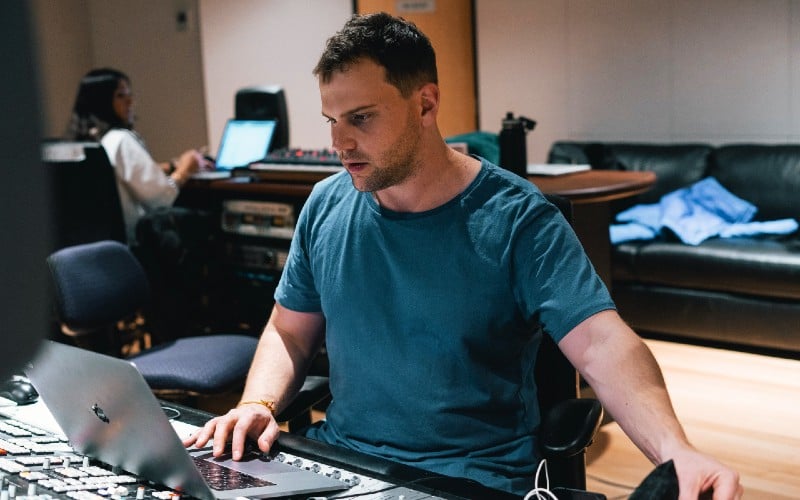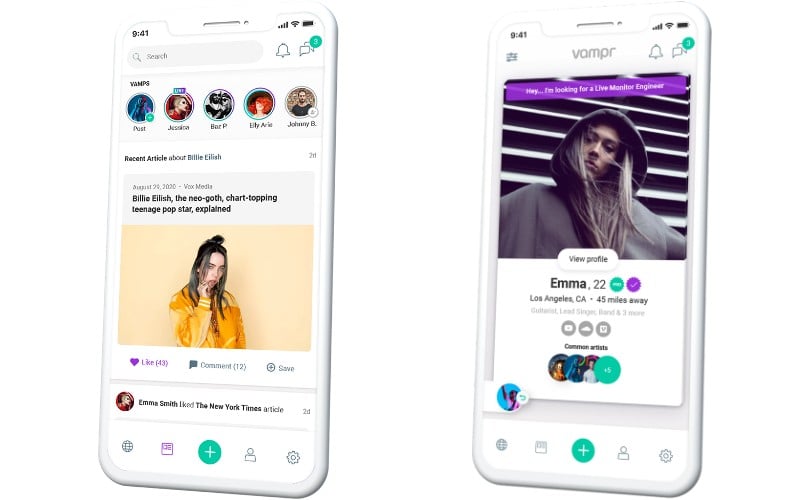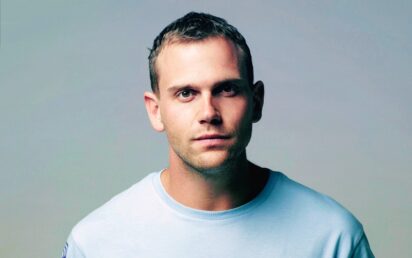Building a startup company is a challenging task which requires every ounce of a founding team’s energy, expertise and exertion.
You may be off and running with a scalable platform, adding users at an exponential rate. But what if your lead investor unexpectedly pulled the plug?
That is exactly what happened to Josh Simons. England-born, Australia-bred and now based in Los Angeles, Simons co-founded Vampr – dubbed a ‘LinkedIn for creatives’ which seeks to coordinate the chaos of networking in the music industry – in 2015.
“Our month over month growth was just insane and we were trying to do a Series A round – then the unexpected happened,” he says candidly. “That investor had committed to supporting us into our next stage of growth and development, but pulled out at the very last minute.
“We’d been running at full speed and – I guess you could call this naivety – hadn’t planned for an event where the investor suddenly pulled out all of the money.”
Simons and co-founder Baz Palmer were forced to put the company “on ice” for nine months while they raised fresh funding. “I made some severe brutal cuts and we rode the wave,” he acknowledges to TechBlast from his home in LA.
“It didn’t kill us; it just meant that I had to stretch out what we would usually spend in a month to 12 months. I’d always maintained two sets of budgets: the essential, which kept the lights on and meant the platform didn’t look dead when people signed up; then our normal budget, which is 10-times that amount.
“For that period we had to mainly lose people, as headcount is what makes up the majority of startup churn. Everyone had to go and find work for a period, but most of them came back when we were able to offer that to them. We’ve got a pretty loyal team.”
Stealth mode
Returning to ‘stealth mode’ for a period had its advantages. “The whole experience was actually a blessing because it gave us the time to rebuild the platform while no one was really talking about us,” he says.
“Crucially, we’d already come up with a blueprint for how we would build the company a second time around. After we raised capital again it took us about a year and a half to build, and a couple of million dollars. We relaunched in August and have been sprinting ever since.
“We should we dead… I mean, most startups statistically are dead within two years. We’re still here five years later. We got through it and survived.”
Vampr followed that life-saving investment, led by Kentucky-based venture firm RZN8 Capital, with an oversubscribed crowdfunding round which saw more than 2,000 investors pledge a total of £1.9m. A new Series A round is in progress.

It has surpassed a million users following relaunch, onboarding an impressive 400,000 new users in the last 12 months alone. The platform now enables over 6.5 million connections across 190+ countries to create over 220,000 original musical compositions.
Modern Myspace
Simons agrees that Vampr is Myspace for the modern age – a platform which is sorely needed as LinkedIn simply doesn’t cater to the networking needs of the creative industries.
“Only about 30% of people who work in those fields are represented on LinkedIn, which is very much a resumé (CV) platform. It’s great if you’re looking for an accountant or lawyer and want to quickly see their credentials, but in the creative industries we’re not really judged by how many projects we’ve done, but by their quality,” he explains.
“The requirements to exhibit one’s work and how you want to present yourself to the world is very different to a simple resumé page.
“No one has nailed this since Myspace. Myspace was a weird time for the internet: it was still very much Web 1.0 in some respects, before the rise of social media and smartphones. [Fox owner] Rupert Murdoch then acquired it and took the platform in a different direction – and ultimately it fizzled out.
“It was the only platform prior to Vampr that served this role in a big way with millions of people. That’s what we’re trying to recreate – but we’re doing it in a much more modern way, with a slick mobile-first user experience.”
Vampr allows people in the creative sector to connect with talent of any kind – be they singers, graphic designers, sound technicians or agents – with the only stipulation being a connection to the music industry. There are now 20,000 skills categories available in the app.

It does this through a Tinder-like swiping system which is more engaging and less laborious to use than LinkedIn.
Frontman
Simons, frontman for former band Buchanan, cites his own profile on the app as an example. “I identify as a band, as a producer and a songwriter. I put my pictures up on there, I’ve got my biography on there, I’ve got our best songs, our best videos – what we call the audition section – it’s linked to my Instagram page and all my other socials.
“For the last tour I did, when we were playing arena shows, I might have needed a 3D live graphics designer – someone who could do the stuff behind me on the big screens – so I’d put in those requirements, choose the city that I was touring in, choose an age range of 20-50 because it doesn’t really matter how old they are for that particular job, and hit search.
“I might be going about my business searching for my special effects guy, and then all of a sudden, I’ll get an inbox message from a publisher saying ‘are you signed?’… and start a conversation from there.”
Simons, who likens Buchanan to Canadian indie outfit Arcade Fire, had the original idea for the business when struggling to grow the band outside its home market of Australia.
“In music and probably any creative field, your outcomes will change depending on people – who you know and their competency,” he says.
“Are they willing to work with you? Do they believe in what you’re doing? It could be a radio plugger looking at your stats and deciding that they have a pathway to sell the song into radio; or it could be a promoter looking at your previous ticket sales and listening to your music, and deciding that they’re willing to give you a chance at a slightly bigger venue. That’s one of the biggest problems that faces young, talented creatives.
“All creative verticals are very much joined at the hip: what they have in common is this serendipity in chaos which leads to the end product – the chaos of the process, the chaos of the business, the ridiculousness of the structures and how it’s all set up… all somehow lends itself to these pieces of work that we enjoy consuming.
“How do you coordinate that chaos? That’s what Vampr is all about.”
Walk and chew gum
The company’s premium service, Vampr Pro, includes digital distribution – allowing users to share their music on Spotify, Apple Music and YouTube while keeping 100% of their royalties. Its users have enjoyed a combined 62.5 billion streams, with $162m flowing directly into their pockets.
Currently, 3% of users sign up to the $4.99-a-month service, which includes unlimited swipes and direct messages to people you’re not connected with.
“You’ve got to learn how to walk and chew gum,” he says of the decision to build Vampr 2.0 with a paid-user model. “The days of trying to build something really quickly and then worrying about how to monetise later are probably more or less done.
“You have to be building businesses from the outset, not just just social destinations. Clubhouse was an exception, but you saw how quickly that crashed and burned.”
At its current growth rate, Vampr is on track to hit 2.8m users by December 2022 and add a further 50m users in the next five years.
‘People aren’t used to hearing my accent’ – CEO of listed business
It is already used by many industry heavyweights to source new talent – from Kanye West’s Grammy-winning producer, Antony Kilhoffer, to Rae Khalil from hit Netflix music competition show Rhythm + Flow, hosted by Queen Latifah and Chance The Rapper.
However its focus for now is on the grassroots rather than celebrity endorsements.
“We could have brought on Drake or Kanye West right at the start, and had one day of really crazy numbers; but that’s not really how networks work. It would probably fall off a cliff edge… you’d never recover and have to give away half of the company,” he says.
“If we build it up with millions of kids all around the world, and they go on to make hundreds of thousands of songs together and receive millions of dollars in royalties, that is far more sustainable – and the word of mouth endures.
“Everything we do is measurable and scalable. Right now, we have a daily advertising budget which accounts for around 80% of new users – 2,000-3,000 a day – while 22% are word of mouth.”
The business is based in LA but has a tech R&D team in Australia as well as an A&R operation in London. “Ever since COVID broke out I’ve been in LA. It’s the longest I’ve ever stayed put… it’s very frustrating,” says Simons.
Does he miss making music himself? “Tremendously – I think about it all the time. Those are some of the most fun days ever, but you can’t do that for the rest of your life… although I think Bono might disagree!”


